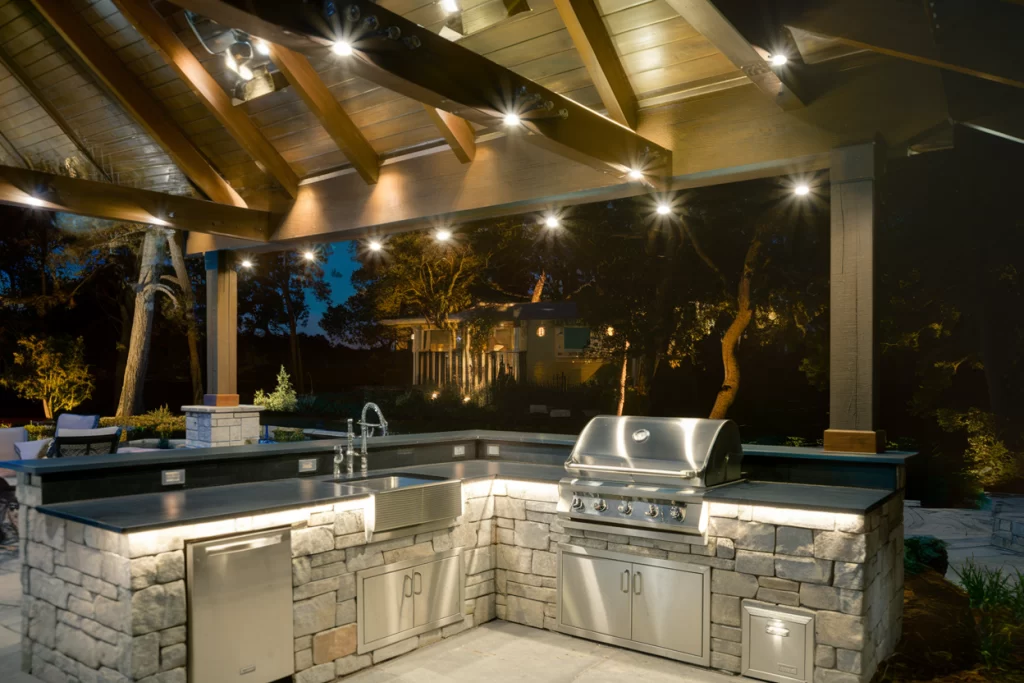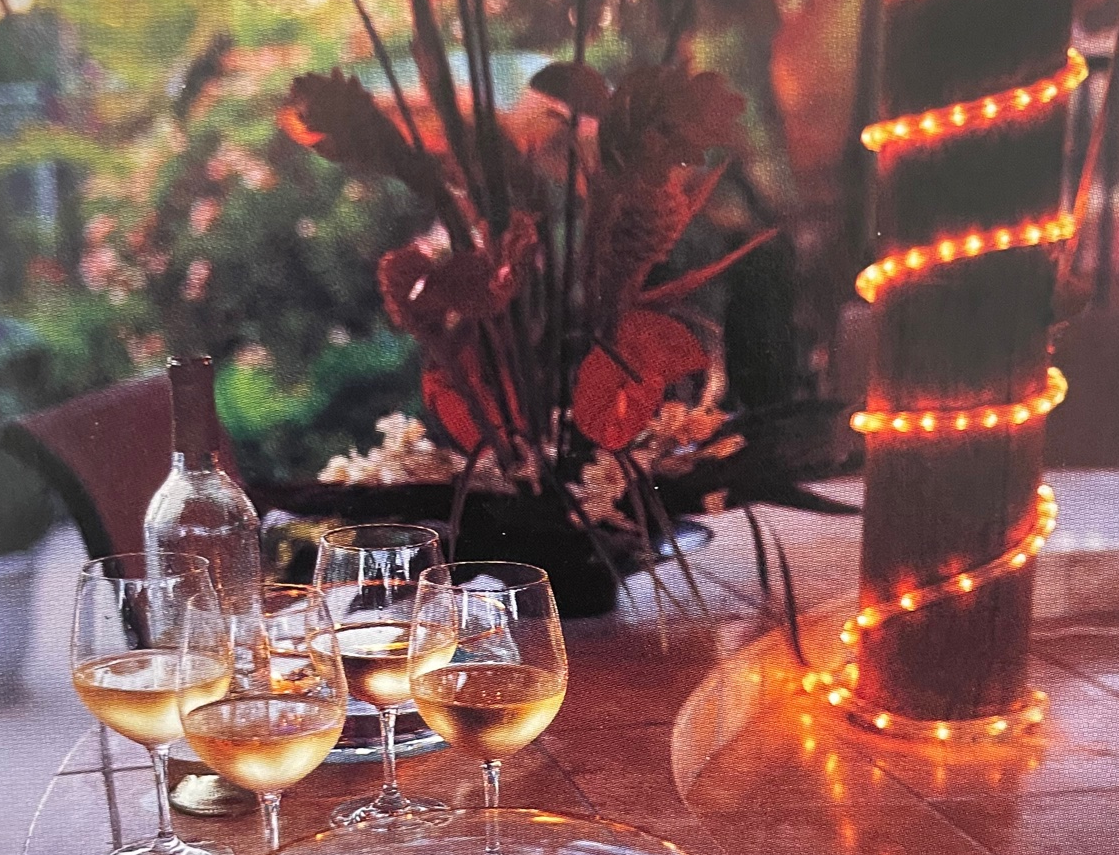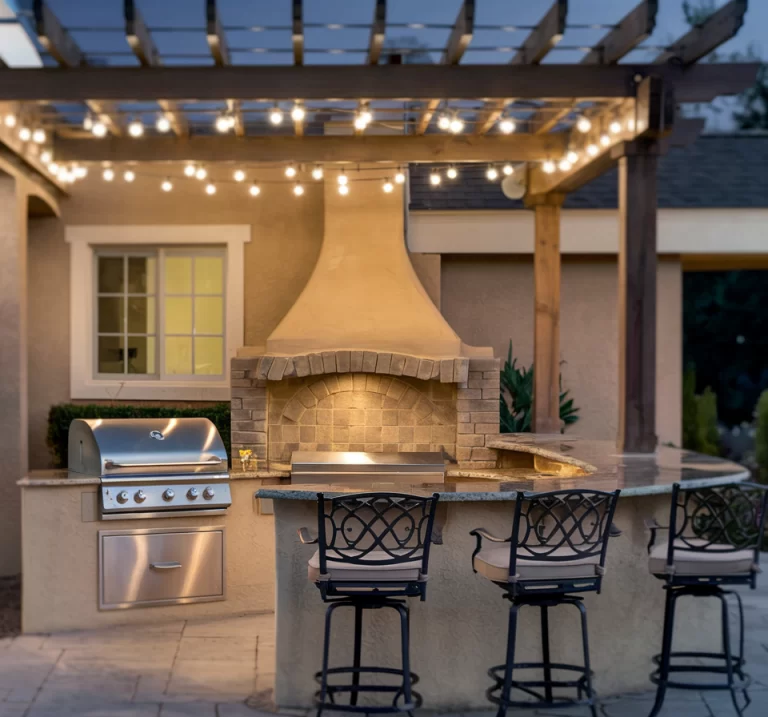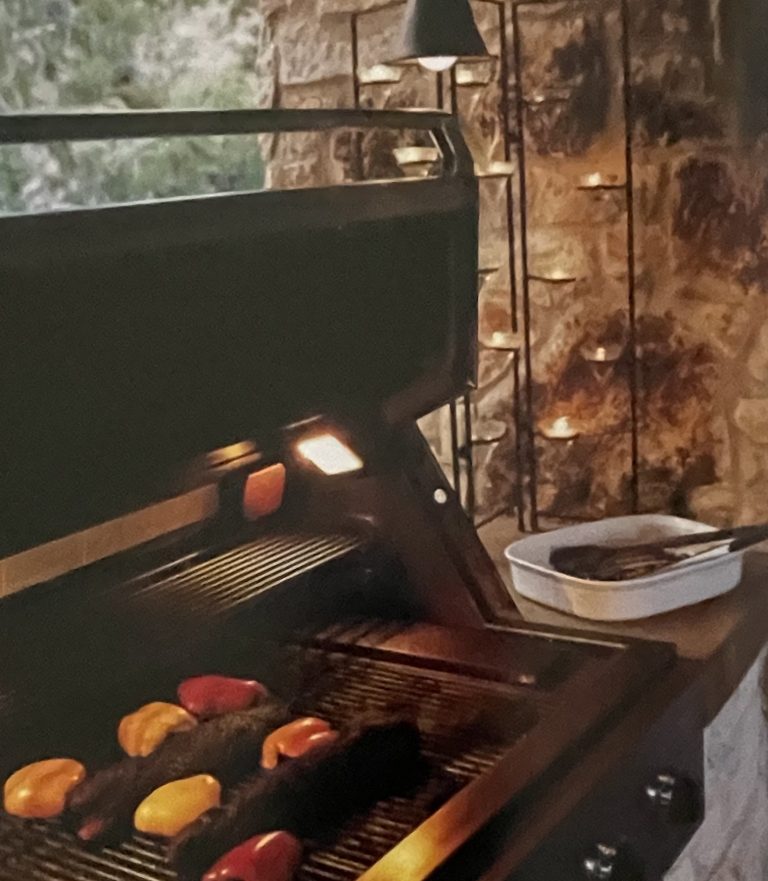LED Lighting for Outdoor Kitchens

Outdoor Kitchen LED Lighting Guide
With outdoor kitchens becoming increasingly popular, it’s critical to think about outdoor kitchen lighting to complement the ideal cooking environment while also creating a proper dining ambiance. Proper lighting is required regardless of whether you have only a kettle grill or a whole outdoor kitchen. Because of their energy efficiency, LED lighting has become a go-to solution for an outdoor kitchen.
What is LED Outdoor Lighting?
An LED lamp, often known as an LED light bulb, is an electric light that uses light-emitting diodes to produce light. LED lamps are substantially more energy efficient than identical incandescent bulbs, and they can even outperform most fluorescent lamps.
To produce balanced layers of light, outdoor kitchen designers advise you to use a variety of LED lights. Even in the tiniest kitchen, a single light source is insufficient to provide all of the light required to keep the area safe and functioning.
Outdoor kitchens have advanced to the point that they are effectively an extension of your home’s interior. In addition to top-of-the-line appliances, the room frequently features dining tables and comfy couches for entertaining. These are valuable additions, and adequate outdoor kitchen lighting is essential for you to get the most out of your investment.
You’ll want to think about safety considerations in addition to directed lighting for the kitchen and mood lighting for entertaining areas. Steps and pathways should be illuminated to prevent injury to family and visitors.
Outdoor lighting has grown in popularity in recent years, and aside from being fashionable, there are several practical reasons to appreciate LED lights, including:
- LED lights are usually self-contained and less difficult to install than traditional bulb illumination.
- LED lights have a gentler color than other types of illumination (and come in a variety of colors to suit your tastes)
- LED lights consume less energy than alternative lighting options.
- LED lights can enhance your living environment and create a distinctive ambiance. LED lights can last up to 25 years but typically will last thirty to fifty thousand hours.
Are LED Lights Suitable for Outdoor Use?
For many reasons, including lower energy costs and brighter lighting, LED lights can be used outdoors. The fixture should be UL approved for outside usage and the light fixture housing should be sealed against the elements.
Do LED outdoor lights attract bugs?
LEDs should always be used. LEDs, unlike other light sources, do not release UV rays, which are the light rays that insects are attracted to. There isn’t much more irritating than having swarms of insects hovering over you as you prepare your feast. You may completely prevent the annoyance by using LEDs.
How long do LED lights last?
According to the United States Department of Energy, an LED circuit, also known as a luminaire, is deemed “excellent” until it produces 70% or less of its initial light output. Additionally, as the circuit ages and is used more frequently, the hue of the light emitted will change. So, while the bulb may “last,” it may not meet the requirements for your home or business. LED bulbs will eventually burn out.
It’s crucial to remember, though
- LEDs do outlast other lighting options in terms of lifespan.
- LEDs are the most energy-efficient lighting solution currently available, whether in terms of overall costs, electricity consumption, or longevity. The US Department of Energy has invested much in research and development in the hopes of making LED lighting the standard illumination in both residential and commercial settings in the United States.
When used properly, an LED bulb can last between 30,000 and 50,000 hours, whereas the average incandescent light bulb only lasts 1,000 hours. That’s a significant difference.
How to Use LED Lighting in Your Outdoor Kitchen
Types of Outdoor Kitchen LED Lighting
Outdoor Kitchen Lighting with Line Voltage (120V)
Commercial, security, and public-use applications are the most common uses for line voltage (120V) outdoor lighting. Line voltage outdoor lighting is time-consuming to install and necessitates the services of an electrician. The 120V outdoor lighting line must be buried 18 inches underground, installed in conduit, and connected with sealed junction boxes.
120V outdoor lighting is typically used to light vast areas or regions where intense light is required for working, such as in an outdoor kitchen. Line voltage outdoor lighting fixtures are often large and produce a large amount of light.
Outdoor lighting with line voltage:
- Installation necessitates the use of an electrician.
- Shock hazard necessitates watertight connections.
- Any cable must be buried 18 inches deep or placed within conduit, which necessitates trenching.
- The fixtures for line voltage are somewhat large. There are fewer lighting and fixture options available.
- Costs more than low voltage lighting.
To use line voltage in an outdoor kitchen and LEDs, you simply replace incandescent bulbs with LED bulbs in the fixture.
Low Voltage Lighting for Outdoor Kitchens
You’re probably aware of low voltage landscape lights which are probably the most familiar of all the low voltage lighting options.
The most frequent option for home outdoor lighting is low voltage landscape lights. The fact that they are easier to install, less expensive, and safer, and that you do not need to be a certified electrician to deal with them, are just a few of the benefits of 12V landscape lighting. Because the cable does not need to be buried, low voltage landscape lighting reduces the risk of shock and is simple to install.
If your outdoor kitchen is near a GFCI outlet, you can easily install low voltage lighting on your BBQ island or in your outdoor kitchen when you plug the low voltage transformer into your outlet. This lower voltage lighting is great for ambient light but probably not strong enough for task lighting.
The voltage loss on a lengthy series of lights has often been used as a reason for using line voltage. However, unless the runs are exceedingly long, this is usually not a concern for low voltage systems using modern LED technology and multi-tap transformers.
Wireless LED Lights
Wireless LED lights are either solar powered or battery powered. You can install strip lights or puck lights in your outdoor kitchen to provide pathway lighting or ambient light. These are not usually strong enough to provide intense task lighting in your outdoor kitchen and grilling areas.
Places to Install LED Outdoor Kitchen Lighting
A successful outdoor kitchen lighting plan uses layers of light to provide the right type of light in the right location.
Ambient lighting, such as ceiling fixtures or track lighting, chandeliers, and pendant lights, are the foundation (or where you should start) of a successful lighting strategy.
Following that, you should determine task lighting, such as under cabinet strip lights or pucks, that will be installed above each work zone to provide additional light without casting shadows.
Finally, you can add accent lighting to draw attention to architectural aspects and decorative things in your new kitchen.
LED Lights for BBQ Islands
A single wall-mounted grill lighting fixture may transform rudimentary BBQ facilities into stylish and functional leisure areas.
Barbecue lights make outside cooking safer and more sanitary by allowing people to see what they’re grilling. To make a barbeque grill operate the way it was intended, it’s important to keep the temperature consistent and keep an eye on the color of the food being prepared. This can’t be done efficiently in the dark, and it can’t be done effectively with porch or patio illumination either.
LED barbecue lights provide a customized light source intended specifically for outdoor cooks, rendering food color and texture clearly so cooks can see exactly where the meat is in the preparation process.
Outdoor Kitchen Ambient Lighting
The main source of light in your kitchen is ambient lighting. A combination of different varieties of LED lights can be utilized to add to the light or to fill in where there isn’t enough. When it comes to ambient lighting, it should be uniformly distributed across the space.
The primary source of ambient lighting is usually recessed ceiling lights in a covered space. In the past, halogen or other incandescent sources were commonly employed. Long-lasting, energy-saving LEDs have now replaced the old-fashioned fixtures.
Outdoor Kitchen Accent Lighting
Accent lights, such as toe kick lights, inside cabinet lights, and any other spot where you want to highlight your favorite things, will be included in any well-designed kitchen.
LED interior lights are ideal for displaying serving pieces or memorabilia in glass-front cabinets. Rope lighting can be set behind cabinet face frames, or recessed puck lights can be installed in cabinet tops to provide light from top to bottom. You also don’t have to worry about them overheating inside the cabinet because they stay cool.
Cabinet toe kicks can be lit with rope lights or LED tape. Lighted toe kicks can be functional as well as fashionable. They can be used as a form of path light in areas that require extra security. Install motion sensors to turn on the lights when someone arrives, which is a useful safety feature.
LED lights may be used to illuminate glass countertops from below, creating a dramatic appearance. LEDs can also be utilized to highlight architectural details in your outdoor kitchen roof.
Outdoor Kitchen Task Lighting
While ambient lighting provides the majority of the light in the outdoor kitchen, it frequently casts shadows under cabinets and in corners, making it difficult to read recipes or check the doneness of a steak. Your work areas will be suitably lit by LED task lighting, allowing you to safely prepare meals. Consider the equipment that are commonly used in the kitchen: knives, graters, heat, and flames. You want to be able to see what you’re doing!
Outdoor Kitchen Undercabinet Lighting
Work surfaces are illuminated by undercabinet task lighting, allowing you to work safely and makes a great lighting idea if you have overhead cabinetry.
LED lights are well-suited to undercabinet illumination. LEDs keep cool, unlike halogens, so your hands don’t get hot while you’re working beneath them. If you touch them by accident, you can get burned.
Undercabinet strip lighting LED strip lights and LED puck lights are common undercabinet lighting solutions. LED strip lights are utilized under the cabinet to fully illuminate counter spaces, whereas puck lights are directional and provide a pool of light, making them ideal for task lighting over a cutting board or prep station.
Outdoor Kitchen Undercounter Lighting
Water resistance is the first feature to look for in under cabinet LED lighting. These, unlike work lighting in a conventional kitchen, must withstand the elements. Because they’ll almost certainly be exposed to rain, consider fixtures that are rated for operation in wet environments.
Then, based on the layout of your kitchen, figure out the sort of fixture you’ll need.
- You can utilize a more classic design of under cabinet light if you have traditional cabinets or shelves. For the ideal task lighting, use rope lights or indoor/outdoor puck lights beneath the lowest shelf.
- If your counter has a raised bar or ledge above it but no shelves, you’ll need something low-profile to keep it out of the way. For a streamlined design, LED tape lights should be used. They’ll adhere to the overhang’s lip to give brilliant task lighting.
- You’ll have to get a little more imaginative if you want to build an outdoor kitchen against a wall without cupboards or a bar. You can use a rope light or a number of battery-operated night lights to cast beams down onto the counter where the wall and counter meet.
- The type of outdoor kitchen with a flat surface and no bar or walls is the most difficult to light. If you have a pergola or other type of overhang, hanging pendants or rope lights to illuminate the counters from above may be the best option. If your kitchen is just open to the elements, try incorporating recessed accent lights straight into the countertop for added illumination.
Pendant Lighting for Outdoor Kitchens
A pendant light is a ceiling-mounted fixture that hangs from a rod or chain. They’re a form of surface light as well, but they’re not meant to offer ambient lighting over a big area. They are a hybrid of ambient and task lighting. Pendants boost visibility by bringing light closer to the surface of a table, sink, kitchen island, or grill lighting. Pendant lights come in a variety of forms and color. They can be used as focal points in your kitchen, too, if you’re looking for an outdoor kitchen lighting idea.
Pendant LED lights come in many different types, patterns, and sizes. Drum pendants are light fixtures with a cylindrical drum-style shade that are ideal for use over a bar or in a serving area. Consider installing glass or wooden pendant lights above the outdoor kitchen island if there is a ceiling or overhang above it for additional task lighting.
Can LED lights be used outdoors?
The good news is that LED lights are generally quite long-lasting. It is okay to use LED lights outside as long as they are properly housed and have the appropriate sealing.
One thing to keep in mind is that LEDs come in a variety of certifications, known as Ingress Protection, or IP rating. If you intend to use your LEDs outside and live in a location that is subject to a wide range of weather conditions, it is recommended to choose an LED with a high IP rating.
Heat Sensitive LED Circuits
Near Ho temperatures, LEDs do not operate as well. When placing lighting, keep this in mind. LEDs output the majority of their energy as light rather than infrared heat, making them far less flammable than previous solutions.
However, if the circuits that control the flow of electricity are overloaded or unprotected when exposed to high temperatures – think outdoor lighting or lights near a fireplace or heating unit – they will break down more quickly.
LED Wattage
The proper use of your LED bulbs is also critical to their success and lifetime. If you use a 60-watt bulb in a 100-watt fixture, the bulb will not last as long and will be more likely to break down.
In contrast, if your bulb requires more power than the outlet can supply, the bulb will not work as well as it could, and you will be spending money on electricity.
Is it possible to leave LED lights on?
There is little risk of fire or fixture damage because they generate largely visible light rather than infrared heat. That isn’t to imply that heat isn’t generated and that it can’t damage or shorten the life of your bulb’s circuit over time.
Regardless, LEDs are perfect for lights that must be on for long periods of time.. They’re also ideal for lights that are difficult to reach or that aren’t constantly visible and don’t need to be changed frequently. Recessed lighting on a high ceiling or motion-activated stair lights are two examples.
Related Articles About Outdoor Kitchen Lighting
Grill Light



